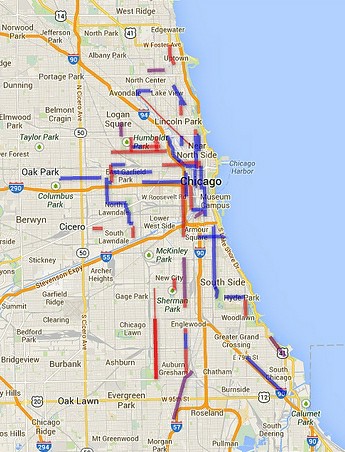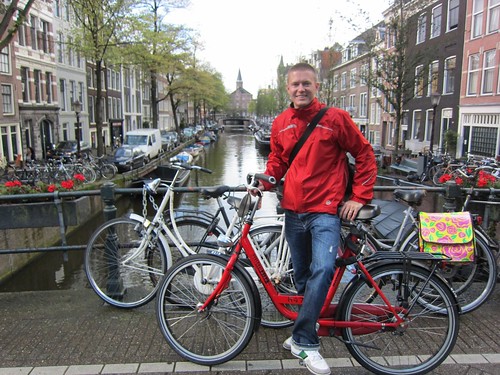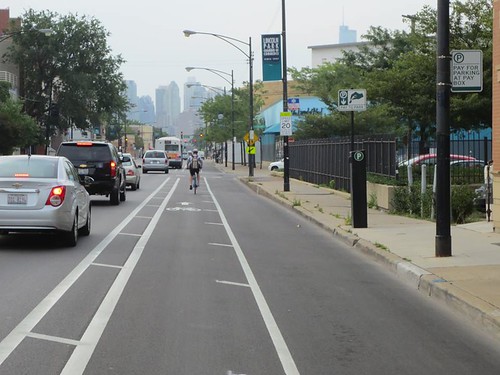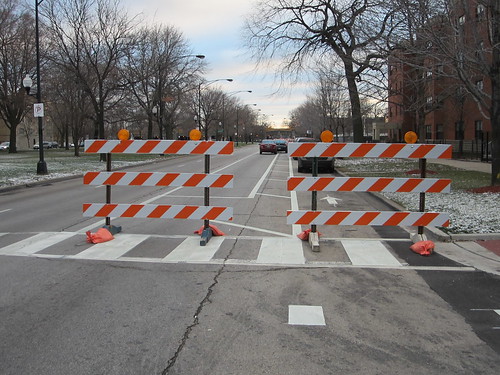We’re currently in the midst of a bike lane building boom. Earlier this year the Chicago Department of Transportation completed groundbreaking protected lanes on Milwaukee from Kinzie to Elston, which involved removing about 50 percent of the parking spaces. Buffered lanes were striped on Wells from Chicago to North. Recently CDOT completed buffered lanes on a two-mile stretch of Madison between Pulaski and Central, and this week the department began or continued installation of the following 11 miles of bikeways:
- Clybourn (North to Belmont): 2.8 miles of buffered lanes -- construction was slated to end today
- Vincennes (103rd to 84th): 2.65 miles of protected and buffered lanes -- striping was slated to end today, flexible posts will be installed in the near future
- Kedzie (North to Palmer): .75 miles of buffered lanes -- construction started this week
- Archer (State to Cermak): .60 miles of buffered lanes -- construction started this week
- Halsted (Garfield to Pershing): two miles of buffered lanes -- construction started this week
- Berteau (Lincoln to Clark): .85 miles of neighborhood greenway -- construction ongoing
- South Shore (79th to 71st): 1.25 miles of buffered bike lanes -- construction started this week
It’s worth noting that all of Clybourn and South Shore, most of Archer, and the southernmost three blocks of Vincennes are state jurisdiction roads. The Illinois Department of Transportation has prohibited the city of Chicago from installing protected lanes on IDOT streets, citing safety concerns. The real reasons for the ban aren’t clear yet, but an email obtained from CDOT via a Freedom of Information Act Request indicated that concern for cyclist’s safety wasn’t one of them.
In addition to the roughly 15 miles -- about four of them protected -- completed or under construction this year, CDOT had a bid opening this week for a federally-funded project to build 15 more miles of buffered lanes this year. The department hopes to complete 35 miles of buffered and protected lanes in 2013, for a total of 65 miles -- 20-25 of them protected -- installed since Mayor Rahm Emanuel took office in May 2011. The current goal is to install 100 miles of protected and buffered lanes by May of 2015. This means CDOT will really need to hustle to get the last 35 miles in next spring.
I recently sat down with CDOT Project Manager Mike Amsden to discuss these projects. The department currently refers to protected lanes as “barrier-protected” and buffered lanes as “buffer-protected.” For simplicity, I have altered his quotes to include the more commonly used terms.
Amsden says he’s particularly excited about the bikeway on Vincennes, which is designated as a Spoke Route in the city’s Streets for Cycling Plan 2020. While conventional bike lanes previously existed on this stretch, CDOT removed them to increase motor vehicle capacity on the street during the Dan Ryan Expressway reconstruction from 2006 to 2008. In general, the southbound bike lane will be buffered with curbside car parking; the northbound lane will be curbside with a painted buffer to the left plus flexible posts that will discourage, but not prevent, drivers from entering the bike lane.
He said that with improvements for pedestrians, bicyclists and motorists, Vincennes will truly become a complete street. “Vincennes is really what we’re trying to do as a department, making streets safer for everybody,” he said. “We’ve done a lot of data collection out on Vincennes, we’ve met with a couple of people in the community and the alderman, and speeding is the number one concern out there.”
There were 981 reported crashes, with 25 serious injuries ands three fatalities, on this street between 2006 and 2010. Speed measurements taken last year at 92nd and Vincennes found that 63 percent of southbound motorists and 86 percent of northbound drivers were speeding. Sixteen percent of the southbound motorists were traveling above 40 mph, and 41 percent of the northbound ones were. “That’s incredibly fast and incredibly dangerous,” Amsden said.
The new configuration will act as a road diet by narrowing the car lanes, which will calm traffic and shortening pedestrian crossing distances. CDOT will also install high-visibility crosswalks, pedestrian refuge space, and turn lanes for motorists. “There’s not a lot of traffic out there right now, and it’s kind of this wide, open undefined space,” Amsden said. “At times [the broad two-lane street] would act as two lanes in each direction, so we’re clearly marking it as one lane in each direction.” He said CDOT hopes to eventually build bike lanes on Vincennes from the southern border of the city all the way to its northern terminus at State.
The Archer bike lane installation will include a more dramatic road diet, converting four lanes to three. The Halsted project mostly involves a two-lane roadway, but a quarter-mile segment in the middle of this stretch that currently has four lanes will undergo a four-to-three conversion to make it consistent with of the rest of the roadway.
Kedzie currently has conventional bike lanes for most of the project area, but they drop out between Moffat and Armitage to make room for four lanes of car traffic with shared lane markings. “That was done a few years back when maintaining auto capacity was the norm,” Amsden explained. “We had a request from [26th ward Alderman Roberto] Maldonado to make it better for bikes. He didn’t like the fact that you had a bike lane that disappeared and then the bike lane came out.” That’s interesting because, at Maldonado’s request, bikes were not accommodated in a 2010 road diet on nearby Humboldt Boulevard. Hopefully this means alderman has become more bike-friendly in recent years. The whole segment of Kedzie will be converted to two travel lanes with buffered bike lanes.
Steven Vance has noted that at several of the intersections on Clybourn, which would have been wide enough for protected lanes were it not for the IDOT ban, the new buffered lanes disappear well before you get to an intersection. "These are IDOT routes, so there are different requirements we need to meet on their roadways," Amsdem explained. “So at times, depending on the amount of traffic volume and the amount of turning motorists at certain intersections, turn lanes need to be a certain length, and that’s usually [why the bike lanes drop out].”
When Emanuel stated his goal of building 100 miles of protected bike lanes within his first term in his Chicago 2011 Transition Plan, protected lanes were defined as "separated from traveling cars and sit[ing] between the sidewalk and a row of parked cars that shield cyclists from street traffic." I asked Amsden about the fact that the vast majority of these new projects are buffered, not protected lanes.
In addition to the obstacle of the IDOT ban, Amsden seemed to say that some parts of the city that don’t already have high ridership aren’t ready for protected bike lanes. “Many of these projects are in parts of the city where we don’t have a lot of bike infrastructure yet,” he said. “We’ve heard on a regular basis when we’re talking to stakeholders in these communities that, ‘You need to walk before you can run.’ So taking out parking and taking out travel lanes, it’s not always going to work in some neighborhoods, but putting in a buffered lane is a great start. It can help get people out riding and start that mode shift. You can’t always go full blast and put in something that’s great for bikes when you don’t have the ridership yet.”
For example, last year CDOT ran into trouble when local residents complained to 24th Ward Alderman Michael Chandler after the department relocated parking for protected bike lanes on Independence Boulevard. Although the alderman had previously approved the lanes, he insisted that they be removed, and CDOT agreed to downgrade them to buffered lanes. “We may have pushed the envelop a little bit and we probably could have done [outreach] better and been successful in pushing the envelope, but we learned our lesson,” Amsden said.
CDOT’s hard work getting in many miles of buffered bike lanes installed this summer is laudable, and it’s certainly more of a challenge to reconfigure the street for protected lanes in neighborhoods that aren’t already bike-friendly. However, if we’re serious about getting more risk-averse people to try transportation cycling, it’s important to install as many “eight to eighty” facilities, which provide physical protection from cars, as possible. Hopefully in the future we’ll see the department do the necessary outreach and push a little harder to install more protected bike lanes all over the city.
Streetsblog Chicago will not be publishing on Monday. Have a great Labor Day!









